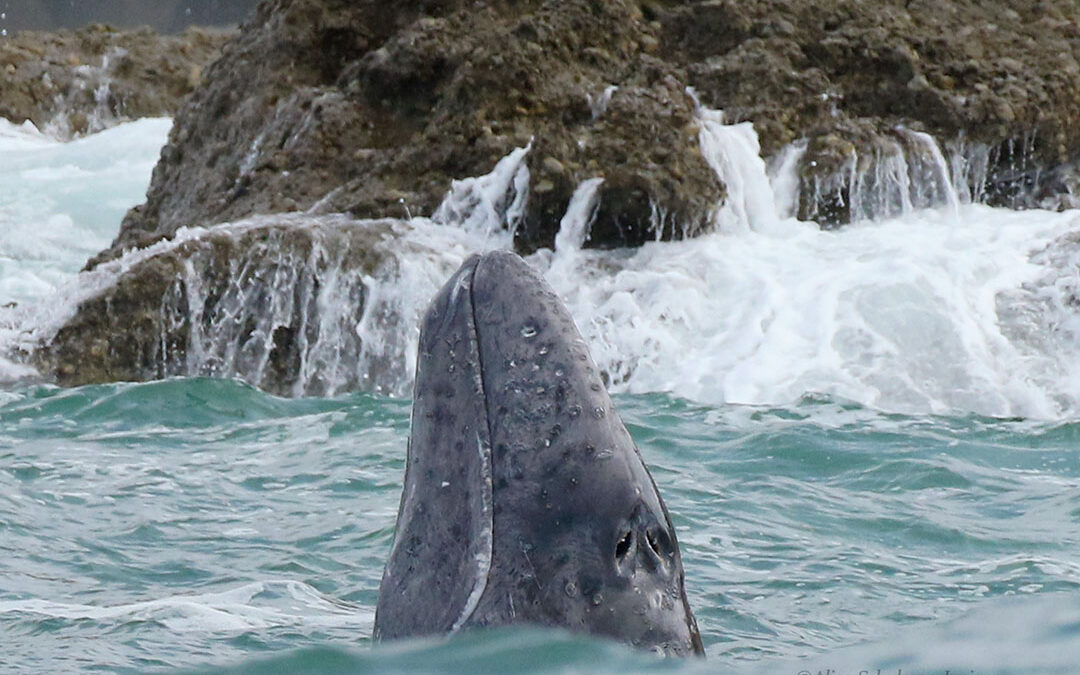Photo by Alisa Schulman-Janiger
ACS/LA GRAY WHALE CENSUS AND BEHAVIOR PROJECT: 2014-2015
Census Project Director/Coordinator: Alisa Schulman-Janiger
Email: janiger@cox.net
For daily sighting details, please visit: www.acs-la.org
Higher gray whale counts, record numbers of southbound gray whales and northbound calves, record sightings of humpback whales and Pacific white-sided dolphin, and at least two days of very rare false killer whale sightings highlighted our 2014/2015 ACS/LA Gray Whale Census and Behavior Project. This is the 35th season (32nd consecutive season) that the American Cetacean Society’s Los Angeles Chapter has sponsored a gray whale census project from the Palos Verdes Peninsula. Our cliffside post is on the patio of the Point Vicente Interpretive Center (PVIC), 125 feet above kelp beds and rocky shoreline, with a seafloor that drops off abruptly nearshore. Trained volunteers collect data on gray whales and other cetaceans (identifications, counts, and behaviors). All participants use binoculars (most with reticles and compass), and several use spotting scopes to confirm and detail sightings. Weather data (visibility and sea conditions) is recorded at least twice hourly.
COVERAGE: Our census station operated for 2,101 hours over the 177 days between 1 December 2014 and 25 May 2015 (averaging nearly 12 hours/day). The 108 volunteers contributed 11,997 effort hours. The twelve core volunteers that donated over 200 hours each, totaling over 35% of our effort hours (and the number of volunteered days) include: Joyce Daniels (160), Greg Gentry (131), Sheila Parker (109), Gerrie Teague (109), Denise Donegan (73), Mike Malone (72), Kathy Beckman (71), Bob Jensen (64), Richard Scholtz (58), Gordon Gates (53), Corine Sutherland (50), and Cynthia Woo (44). Thirty-four additional volunteers donated 100-199 hours each, totaling nearly 39% of our effort hours. Experienced observers anchor all shifts.
GRAY WHALE COUNTS ROSE: We spotted 1,902 southbound and 2,141 northbound gray whales (1,214 southbound and 1,741 northbound gray whales last season). This was by far our record high southbound count, and our 6th highest northbound count (highest in 27 seasons). Whale counts have widely fluctuated over 31 previous seasons: southbound numbers varied from 301-1,301, and northbound counts varied from 521-3,412. Although most of the ~20,000 gray whales migrate past California, we spot only a small proportion. Gray whales, especially adults, off Palos Verdes tend to travel further offshore – notably during the southbound migration. Northbound whales, particularly cow/calf pairs, tend to hug the coastline. These trends, combined with extended springtime observation hours, produce higher northbound counts. Shifting migratory corridors and weather conditions result in annually fluctuating shore-based counts. The number of whales that complete the migration varies, and feeding ground conditions (especially ice coverage) affect migratory timing and corridors. Poor visibility drastically affects counts; fog compromised our visibility during portions of somewhat fewer days this season (55) as last season (66).
PEAKS AND TURN-AROUND DATES: For the fourth consecutive season, the southbound migration started early, with more whales: we had record high December counts of 393 southbound (364 southbound, 4 northbound last season). The peak southbound count was 62 whales on 7 February; our previous peak counts ranged from 15-98. We spotted 259 southbound whales during the peak southbound week of 24-30 January (190 last season). Instead of the typical gap, we had a rare extended overlap between migration phases. The official turn-around date (when daily northbound whales exceed southbound whales) was on 22 February – a bit later than usual. We spotted 81 northbound whales during the “southbound migration”, and 95 southbound whales during the “northbound migration”. Our peak northbound count of 79 grays occurred on 10 March and 17 March. Previous northbound peaks counts have ranged from 20-152. We recorded 395 gray whales during the peak northbound week (main migration pulse) of 5-11 March (296 last season).
CALF COUNTS: We spotted 50 newborn southbound calves (2.6% of southbound migrants), from 19 December-7 March, the lowest percentage (0.5%) was recorded in 1988-1989. (Last season we saw 14 newborn calves: 1.2% of the southbound migrants). Our record high southbound calf count occurred during the 1997-98 season (106 calves, 8.6% of southbound migrants). Previous southbound calf counts ranged from 3-60 (0.5%-8.9% of southbound migrants). We tallied a record *318 northbound calves (14.9% of northbound migrants), between 9 March-22 May, peaking with 19 calves on 6 May. This surpassed last season’s record northbound calf count: 286 northbound calves (16.4% of northbound migrants). Previous record calf counts included 260 northbound calves (22.9% of northbound migrants) in 2011-2012, and 222 calves (13.8% of northbound migrants) in 1996-97. Our other calf counts ranged from 11-196 (0.9%-18.5% of northbound migrants). We recorded 100 cow/calf pairs (207 gray whales) between 3-9 May, and 99 cow/calf pairs (206 gray whales) between 30 April-6 May. These were our peak northbound weeks (cow/calf migration pulse); this pulse generally peaks 5-6 weeks later that the main pulse, which allows calves to nurse longer and strengthen swimming skills in Baja lagoons before initiating their perilous migration northward. We also logged additional probable cow/calf sightings: 4 southbound pairs, and 5 northbound pairs.
BEHAVIORS AND HUMAN INTERACTIONS: We watched gray whales milling, rolling, lunging, breaching, spyhopping, bubble blasting, and mating, and nursing. Many calves were playing in kelp, rolling on moms and riding on their backs. We noted probable bottom feeding: whales repeatedly surfaced in mud clouds. We saw pods separate and merge. On 26 days, we witnessed near-collisions involving a total of 35 boats that closely approached whales; on 2 days, we saw near-collisions with a total of 4 jet skis. Grays whales clearly reacted: usually direction changes (inshore, offshore, turn around, go into a cove); also breach, spyhop, head lift, fluke slap, zig-zag, longer dives, speed up, slow down, become low profile or disappear, and groups split up
HIGHER COUNTS: Our higher gray whale counts reflect trends reported by other coastal census stations such as that run by NMFS (National Marine Fisheries Service), who conducts the official gray whale census (and Gray Whales Count in Goleta). NMFS’s 2006-2007 population estimate was 19,126; the current estimate is 20,000-22,000. Gray whales were removed from the endangered species list in 1994. Fluctuations in wild populations, the number of whales that complete the migration, weather conditions, and observer experience affect whale counts. Feeding ground conditions impact migratory timing and paths. The gray whale population dropped with a major mortality event (1999 and 2000), followed by three seasons of low calf production. Over the past several years, Arctic warming has led to a northward shift in distribution of gray whale prey (mud-dwelling shrimp-like amphipods): they thrive in cooler water, feeding on algae that fall from ice sheets. Gray whales shifted northward, following their prey; strandings decreased and calf production increased. Although we saw an early migration this season, in other seasons grays have ignored the initial migration cue (shortened daylight hours) so that they can rebuild blubber that allows them to fast during migration and on Baja nursery grounds, and provides energy to withstand disease, storms, and killer whale attacks. Gray whale calf recruitment remains very healthy; high numbers of documented calves continue to reverse the past trend of lower counts.
OTHER SPECIES SIGHTED: We spotted 12 other marine mammal species over 176 days, including record** sightings of Pacific white-sided dolphin and humpback whale. Comparing this season (to last season), we saw common dolphin on 156 days (166**), bottlenose dolphin on 135 days (147**), Pacific white-sided dolphin** on 134 days (54), fin whale on 116-131 days (107-118), humpback whale** on 45-48 days (9-11), minke whale on 12-15 days (18-21), blue whale on 7-22 days (0), Risso’s dolphin on 3 days (20), *KILLER WHALE on 6 days (7), false killer whale on 2-4 days (1), unidentified whale on 21 days (22), California sea lion on 165 days (163), and harbor seal on 93 days (102).
OTHER SPECIES SIGHTED (PREVIOUS SEASONS): sperm whale, pilot whale, northern right whale dolphin, Dall’s
porpoise, beaked whale, northern elephant seal, and southern sea otter.
GRAY WHALE INTERACTIONS: gray whales sometimes interacted with other marine mammals including bottlenose dolphin, common dolphin, Pacific white-sided dolphin, and sea lion. We also observed mixed species groupings: different types of dolphin, and dolphin with sea lion..
MISCELLANEOUS: 1-2 peregrine falcons were spotted on 5 days, and 1 osprey on 4 days; these species continue to recover from DDT (pesticide) contamination that decimated their populations. A breaching shark was spotted on 1-2 days.
*KILLER WHALE: We sighted a well-known transient (mammal-eating) matriline – the CA51s – who have shown up here multiple times over the past four seasons! *Please help contribute to our California Killer Whale Project: send photos/sightings to: janiger@cox.net; I will match your images to our catalog, and notify you with the results and sighting histories.
OBSERVERS’ HOURS: (*new observers): afternoon anchor Joyce Daniels (679), Greg Gentry (573), Gerrie Cole Teague (495), Kathy Beckman (384), Sheila Parker (338), Cynthia Woo (315), Denise Donegan (308), Mike Malone (251), Gordon Gates (233), Corine Sutherland (221), Bob Jensen (221), Richard Scholtz (210), Tony Carrillo (191), JoLinda Garnier (180), Gina Autry* (179), Joyce Jessoe (175), Carol Tokushige (171), Wes Tokushige (171), Carl Gadow (168), guestbook archivist Natalie Massey (164), Andy Veek (157), Carla Krysiak (150), Carla Mitroff (148), Laurie Thomson (147), Census Project Director/Coordinator Alisa Schulman-Janiger (145), Rod Jensen (142), Stacy Gremminger (141), Tina Hoff (137), Barbara Stone (136), Mary Morrison* (132), Dee Whitehurst (129), Chad Sprouse* (127), Kim Watson (125), Christy Varni (124), M’Liz Callender (123), Stephanie Bryan (121), Lynn White (121), Nancy DeLong (116), Pam Ryono (112), Amy Heintz (111), Skip Eastman (108), Libby Helms (106), Betty Larson (106), Cheryl Revkin* (104), Stephanie Brito (103), Eric Hemion (102), Bette Williams (99), Pat Ashenfelter (96), Miriam Moses* (94), Hop Tarrant* (90), Reba Devine (89), David Zahniser (86), Jean Woodrow (84), Robin Riggs (73), Sally Sadler (73), Pat Harpole (72), Tom Budar (70), Tammy Da Costa Gomez (68), Dave Morse (68), Rachel Narr* (66), Ken Ragland (66), Erlinda Cortez (65), Larissa Schultz* (65), Jo Bonds (62), Jean Rodgers (62), April Ryan (60), Karl Veek (59), Terry Bidle (58), Karin Campbell (56), Kris De-Roo (56), Meta Dunn* (55), Richard Kawasaki (55), Justin Greenman (54), Stan Kaminski (53), Suzan Carne (52), Deborah Leon (52), Tricia Horn (51), Joyce Neu (50), Paul Nitchman* (48), Irene Kurata (45), Louisa Kosel* (42), Destiny Lauro* (41), Larry Howe (40), June Guinan* (40), Donna McLaughlin (39),Vikki Franck (39), Candy Brassard* (39), Dave Brassard* (39), Joan Krausse* (38), Eric Austin Yee (37), Carol Harrison* (37), Janet McClellan (37), Ben Barnes* (36), September Sucher (35), Victoria Chalaya (35), Terry Hayes (31), Kelly Gurvis* (31), Casey Chase Wang (29), Robin Riggs – Colorado (24), Britt Rogers Simon (24), Mario Morena (23), Norma Lira (21), Mary Drenick* (21), Laura Marcella (18), Sage Mears* (18), Lisa Margolis (18), Kris Clifford (15), Kate Gurvis* (14), Leslie Brucker (10), and Mike Brucker (10).
IN MEMORIUM: Beloved 86-year-old census volunteer FRAN AUSTIN passed away on 8 September 2015; she donated 7,435 hours in 1,015 days (28 seasons)! We will miss this treasured, enthusiastic whale watcher (and past anchor) who contributed so much to our project. Fran even traveled here annually for 20 years after moving to Colorado, just to continue volunteering with our census!
GUESTBOOK LOG VISITORS: USA – 996 (36 states, Oregon highest). Foreign – 168 (31 foreign countries, UK highest)
SPECIAL THANKS: We especially thank anchor Joyce Daniels for daily updates and graphs, and Dave Janiger for computer entries.
JOIN US! Contact Alisa Schulman-Janiger at: janiger@cox.net. No experience necessary: on-site training in November and December. Highly recommended: attend the Whalewatch Training Class at Cabrillo Marine Aquarium (CMA) [(310) 548-7563; www.cabrilloaq.org], co-sponsored by CMA and ACS/LA (www.acs-la.org). On Tuesday nights, October-March, volunteers are trained to become Whalewatch boat guides and classroom lecturers. ACS/LA offers free lectures from invited specialists the last Tuesday of each month at the Cabrillo Marine Aquarium, and all day whalewatching trips: gray whales off Santa Catalina Island in March; humpback and blue whales in the Santa Barbara Channel – summertime (www.acs-la.org).
*Please contact Census Project Director for permission to cite this copyright-protected data in publications: janiger@cox.net.

